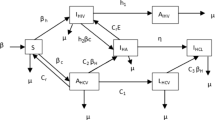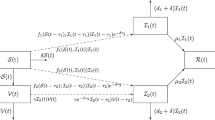Abstract
The SIR (susceptible–infected–recovered) is one of the simplest models for epidemic outbreaks. The present paper demonstrates the parametric solution of the model in terms of quadratures and derives a double exponential analytical asymptotic solution for the I-variable, which is valid on the entire real line. Moreover, the double exponential solution can be used successfully for parametric estimation either in stand-alone mode or as a preliminary step in the parametric estimation using numerical inversion of the parametric solution. A second, refined, asymptotic solution involving exponential gamma kernels was also demonstrated. The approach was applied to the coronavirus disease 2019 (COVID-19) pandemic in six European countries—Belgium, Italy, Sweden, France, Spain and Bulgaria in the period 2020-2021.








Similar content being viewed by others
Data availability
The COVID datasets were downloaded from ECDC using https://opendata.ecdc.europa.eu/covid19/casedistribution/csv. The analysis pertains to the version from 14 Dec 2020, which covers the period 1 Jan 2020–14 Dec 2021. A second dataset was downloaded on 15 Sept 2021. Inspection of the dataset demonstrated that the new data started from 1 March 2021 and covers the 31 countries from the European Economic Area (EEA).
References
Yadav, S.K., Akhter, Y.: Statistical modeling for the prediction of infectious disease dissemination with special reference to COVID-19 spread. Front. Public Health (2021). https://doi.org/10.3389/fpubh.2021.645405
Kermack, W.O., McKendrick, A.G.: A contribution to the mathematical theory of epidemics. Proc. R. Soc. Lond. Ser. A 115(772), 700–721 (1927). https://doi.org/10.1098/rspa.1927.0118. (Containing Papers of a Mathematical and Physical Character)
Martcheva, M.: An Introduction to Mathematical Epidemiology. Springer (2015). https://doi.org/10.1007/978-1-4899-7612-3
Hethcote, H.W.: The mathematics of infectious diseases. SIAM Rev. 42(4), 599–653 (2000). https://doi.org/10.1137/s0036144500371907
Rodrigues, H.S.: Application of SIR epidemiological model: new trends. Int. J. Appl. Math. Inform. 10, 92–97 (2016)
Ahmetolan, S., Bilge, A.H., Demirci, A., Peker-Dobie, A., Ergonul, O.: What can we estimate from fatality and infectious case data using the susceptible-infected-removed (SIR) model? A case study of COVID-19 pandemic. Front. Med. (2020). https://doi.org/10.3389/fmed.2020.556366
Nguemdjo, U., Meno, F., Dongfack, A., Ventelou, B.: Simulating the progression of the COVID-19 disease in Cameroon using SIR models. PLoS ONE 15(8), e0237832 (2020). https://doi.org/10.1371/journal.pone.0237832
Postnikov, E.B.: Estimation of COVID-19 dynamics on a back-of-envelope: does the simplest SIR model provide quantitative parameters and predictions? Chaos Solitons Fractals 135, 109841 (2020). https://doi.org/10.1016/j.chaos.2020.109841
Record, N.R., Pershing, A.: A note on the effects of epidemic forecasts on epidemic dynamics. PeerJ 8, e9649 (2020). https://doi.org/10.7717/peerj.9649
Barlow, N.S., Weinstein, S.J.: Accurate closed-form solution of the SIR epidemic model. Phys. D Nonlinear Phenom. 408, 132540 (2020). https://doi.org/10.1016/j.physd.2020.132540
Kudryashov, N.A., Chmykhov, M.A., Vigdorowitsch, M.: Analytical features of the SIR model and their applications to COVID-19. Appl. Math. Model. 90, 466–473 (2021). https://doi.org/10.1016/j.apm.2020.08.057
Carletti, T., Fanelli, D., Piazza, F.: COVID-19: the unreasonable effectiveness of simple models. Chaos Solitons Fractals X 5, 100034 (2020). https://doi.org/10.1016/j.csfx.2020.100034
Prodanov, D.: Analytical parameter estimation of the SIR epidemic model. Applications to the COVID-19 pandemic. Entropy (2020). https://doi.org/10.3390/e23010059
Harko, T., Lobo, F.S.N., Mak, M.K.: Exact analytical solutions of the susceptible–infected–recovered (SIR) epidemic model and of the SIR model with equal death and birth rates. Appl. Math. Comput. 236, 184–194 (2014). https://doi.org/10.1016/j.amc.2014.03.030
Kröger, M.: Analytical solution of the SIR-model for the temporal evolution of epidemics. Part A: time-independent reproduction factor. J. Phys. A Math. Theor. 53(50), 505601 (2020). https://doi.org/10.1088/1751-8121/abc65d
Prodanov, D.: Comments on some analytical and numerical aspects of the SIR model. Appl. Math. Model. 95, 236–243 (2021). https://doi.org/10.1016/j.apm.2021.02.004
Corless, R.M., Gonnet, G.H., Hare, D.E.G., Jeffrey, D.J., Knuth, D.E.: On the Lambert W function. Adv. Comput. Math. 5(1), 329–359 (1996). https://doi.org/10.1007/bf02124750
Kudryashov, N.A., Chmykhov, M., Vigdorowitsch, M.: An estimative (warning) model for recognition of pandemic nature of virus infections. Int. J. Nonlinear Sci. Numer. Simul. (2021). https://doi.org/10.1515/ijnsns-2020-0154
Daftardar-Gejji, V., Jafari, H.: An iterative method for solving nonlinear functional equations. J. Math. Anal. Appl. 316(2), 753–763 (2006). https://doi.org/10.1016/j.jmaa.2005.05.009
Vitanov, N.K., Vitanov, K.N.: Epidemic waves and exact solutions of a sequence of nonlinear differential equations connected to the SIR model of epidemics. Entropy 25(3), 438 (2023). https://doi.org/10.3390/e25030438
Pollard, J.H., Valkovics, E.J.: The Gompertz distribution and its application. Genus 48(3/4), 15–28 (1992). https://doi.org/10.2307/29789100
Kirkwood, T.B.L.: Deciphering death: a commentary on Gompertz (1825) ‘on the nature of the function expressive of the law of human mortality, and on a new mode of determining the value of life contingencies’. Philos. Trans. R. Soc. B Biol. Sci. 370(1666), 20140379 (2015). https://doi.org/10.1098/rstb.2014.0379
Borisov, M., Markov, S.: The two-step exponential decay reaction network: analysis of the solutions and relation to epidemiological SIR models with logistic and Gompertz type infection contact patterns. J. Math. Chem. 59(5), 1283–1315 (2021). https://doi.org/10.1007/s10910-021-01240-8
Gumbel, E.: Les valeurs extrm̂es des distributions statistiques. Ann. l’Inst. Henri Poincaré 5(2), 115–158 (1935)
Giubilei, R.: Closed form solution of the SIR model for the COVID-19 outbreak in Italy. https://doi.org/10.1101/2020.06.06.20124313
Corless, R.M., Jeffrey, D.J.: The wright \(\omega \) function. In: Lecture Notes in Computer Science. Springer, Berlin, pp. 76–89 (2002). https://doi.org/10.1007/3-540-45470-5_10
Prodanov, D.: Numerics for the SIR model. Zenodo (2020). https://doi.org/10.5281/ZENODO.8036497
Piessens, R., Doncker-Kapenga, E., Überhuber, C.W., Kahaner, D.K.: Quadpack. Springer, Berlin (1983). https://doi.org/10.1007/978-3-642-61786-7
Errico, D.: Fminsearchbnd, https://www.mathworks.com/matlabcentral/fileexchange/8277-fminsearchbnd-fminsearchcon, mATLAB Central Exchange (2012)
Huppert, A., Katriel, G.: Mathematical modelling and prediction in infectious disease epidemiology. Clin. Microbiol. Infect. 19(11), 999–1005 (2013). https://doi.org/10.1111/1469-0691.12308
Fanelli, D., Piazza, F.: Analysis and forecast of COVID-19 spreading in China, Italy and France. Chaos Solitons Fractals 134, 109761 (2020). https://doi.org/10.1016/j.chaos.2020.109761
Cooper, I., Mondal, A., Antonopoulos, C.G.: A SIR model assumption for the spread of COVID-19 in different communities. Chaos Solitons Fractals 139, 110057 (2020). https://doi.org/10.1016/j.chaos.2020.110057
Blanco, N., Stafford, K.A., Lavoie, M.C., Brandenburg, A., Górna, M.W., Merski, M.: A simple model for the total number of SARS-CoV-2 infections on a national level. Epidemiol. Infect. (2021). https://doi.org/10.1017/s0950268821000649
Rypdal, K., Rypdal, M.: A parsimonious description and cross-country analysis of COVID-19 epidemic curves. Int. J. Environ. Res. Public Health 17(18), 6487 (2020). https://doi.org/10.3390/ijerph17186487
Funding
No specific funding available.
Author information
Authors and Affiliations
Corresponding author
Ethics declarations
Conflict of interest
The author declares no conflict of interest.
Code availability
Reference implementation in the Computer Algebra System Maxima has been developed, and the code is available through the Zenodo repository [27].
Additional information
Publisher's Note
Springer Nature remains neutral with regard to jurisdictional claims in published maps and institutional affiliations.
Rights and permissions
Springer Nature or its licensor (e.g. a society or other partner) holds exclusive rights to this article under a publishing agreement with the author(s) or other rightsholder(s); author self-archiving of the accepted manuscript version of this article is solely governed by the terms of such publishing agreement and applicable law.
About this article
Cite this article
Prodanov, D. Computational aspects of the approximate analytic solutions of the SIR model: applications to modelling of COVID-19 outbreaks. Nonlinear Dyn 111, 15613–15631 (2023). https://doi.org/10.1007/s11071-023-08656-8
Received:
Accepted:
Published:
Issue Date:
DOI: https://doi.org/10.1007/s11071-023-08656-8




